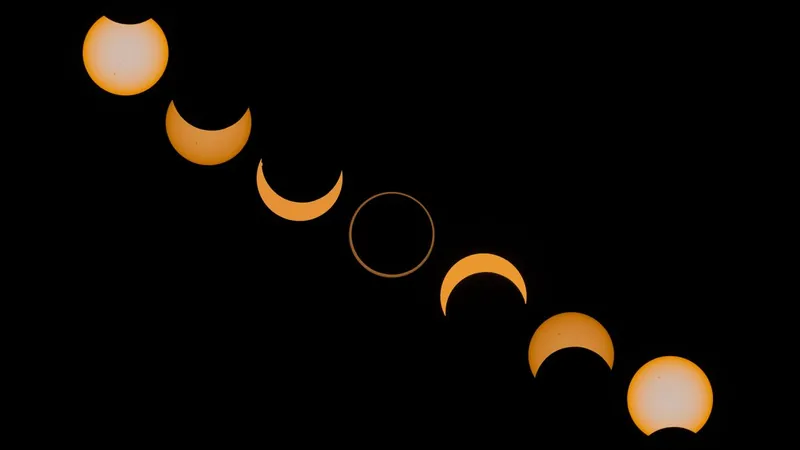
Prepare for an Awe-Inspiring 'Ring of Fire': Annular Solar Eclipse Set for October 2, 2024!
2024-10-02
Mark your calendars!
On October 2, 2024, stargazers and eclipse enthusiasts are in for an extraordinary treat — a spectacular annular solar eclipse, often referred to as a "ring of fire" eclipse, will grace the skies over select regions of the Southern Hemisphere, specifically parts of the Pacific Ocean, southern Chile, and southern Argentina.
During this unique astronomical event, the moon will position itself directly between the Earth and the sun. However, because the moon will be at a slightly greater distance from our planet than during a total eclipse, it will not completely block the sun. Instead, it will reveal a radiant ring of sunlight around the moon, creating that magical "ring of fire" effect. At the peak of this celestial phenomenon, about 93% of the sun will be obscured as the eclipse reaches its maximum brilliance over the Pacific, with a breathtaking duration of up to 7 minutes and 25 seconds of annularity.
Safety First: Eclipse Viewing Guidelines
For anyone hoping to witness this astronomical wonder, it’s crucial to prioritize eye safety. It is NEVER safe to stare directly at the sun without proper solar eclipse glasses. Always remember to use eclipse glasses that meet the international safety standards to protect your eyesight.
What’s Unique About This Eclipse?
This upcoming annular solar eclipse is particularly special due to its longevity and the iconic locations from which it can be observed. The event comes on the heels of the highly anticipated Great North American Eclipse on April 8, 2024, and will attract numerous eclipse chasers eager to immerse themselves in its beauty.
Unlike many eclipses that can last for just a few moments, the ring of fire for this eclipse offers an extended viewing time — providing a longer spectacle than the recent annular eclipse on October 14, 2023, which lasted a maximum of 4 minutes and 52 seconds in the U.S.
The Best Viewing Spots
The path of maximum annularity will stretch across the Pacific Ocean and touch down in southern Chile and Argentina, including the famous Rapa Nui (Easter Island). This remote paradise, celebrated for its imposing moai statues, offers an incredible backdrop for this celestial display. Visitors can plan their viewing at iconic sites such as the 200-foot-long ceremonial platform of Ahu Tongariki, where the alignment of the statues with the eclipse promises a picturesque experience.
Some notable locations for optimal viewing include: - Rapa Nui/Easter Island, Chile (5 minutes, 38 seconds to 6 minutes, 12 seconds of annularity) - Cochrane, Chile (5 minutes, 40 seconds of annularity) - Perito Moreno National Park, Argentina (6 minutes, 17 seconds of annularity) - Puerto Deseado and Puerto San Julian, Argentina (up to 5 minutes)
Weather Forecast: Cloud Coverage Risk
As always, the weather will play a crucial role in viewing conditions. Predictions suggest a significant chance of cloud cover for areas like Rapa Nui and Perito Moreno National Park, estimated at 75% and 90% respectively. This uncertainty reinforces the excitement as millions hope for clear skies to witness this cosmic wonder.
What Happens Beyond October 2?
For those who may miss the 2024 annular eclipse, don’t fret! Additional annular solar eclipses will transpire later, including: - February 17, 2026 (Antarctica) - February 6, 2027 (Chile, Argentina, Uruguay, and parts of West Africa) - January 26, 2028 (Galapagos Islands, Ecuador, and more)
Conclusion: Eclipse Chasing Awaits!
Whether you’re an avid eclipse chaser or a casual observer, the annular solar eclipse on October 2, 2024, promises to be a mesmerizing spectacle that is not to be missed. This celestial event invites everyone to venture into the path of annularity and escape into the wonders of the cosmos as they behold the mesmerizing "ring of fire." Get your solar glasses ready and prepare for a journey into the sky!


 Brasil (PT)
Brasil (PT)
 Canada (EN)
Canada (EN)
 Chile (ES)
Chile (ES)
 España (ES)
España (ES)
 France (FR)
France (FR)
 Hong Kong (EN)
Hong Kong (EN)
 Italia (IT)
Italia (IT)
 日本 (JA)
日本 (JA)
 Magyarország (HU)
Magyarország (HU)
 Norge (NO)
Norge (NO)
 Polska (PL)
Polska (PL)
 Schweiz (DE)
Schweiz (DE)
 Singapore (EN)
Singapore (EN)
 Sverige (SV)
Sverige (SV)
 Suomi (FI)
Suomi (FI)
 Türkiye (TR)
Türkiye (TR)